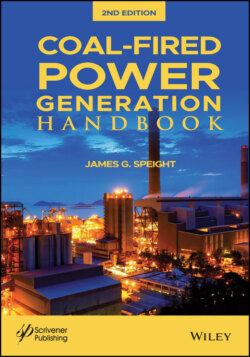Читать книгу Coal-Fired Power Generation Handbook - James Speight G., James G. Speight - Страница 19
1.4.3 Bituminous Coal
ОглавлениеBituminous coal is the black, soft rock and the most common coal used around the world. Formed of many thin layers, bituminous coal looks smooth and sometimes shiny. It is the most abundant type of coal found in the United States and has two to three times the heating value of lignite. Bituminous coal contains 11,000 to 15,500 Btu per pound. Bituminous coal is used to generate electricity and is an important fuel for the steel and iron industries.
Bituminous coal lights on fire easily and can produce excessive smoke and soot (particulate matter) if improperly burned. The high sulfur content of the coal contributes to acid rain.
Bituminous coal commonly contains the mineral pyrite, which can serve as a host for impurities such as arsenic and mercury. Combustion of bituminous coal releases traces of mineral impurities into the air as pollution. During combustion, approximately 95% of the sulfur content of bituminous coal is oxidized and released as gaseous sulfur oxides.
Hazardous emissions from bituminous coal combustion include particulate matter (PM), sulfur oxides (SOx), nitrogen oxides (NOx), trace metals such as lead (Pb) and mercury (Hg), vapor-phase hydrocarbon derivatives (such as methane, alkane derivatives, alkene derivatives, and benzene derivatives) and polychlorinated dibenzo-p-dioxin derivatives and polychlorinated dibenzofuran derivatives. When burned, bituminous coal can also release hazardous gases such as hydrogen chloride (HCl), hydrogen fluoride (HF), and polycyclic aromatic hydrocarbon derivatives (typically represented as PAHs or PNAs). Incomplete combustion leads to higher levels of and polycyclic aromatic hydrocarbon derivatives (which are carcinogenic) but burning bituminous coal at higher temperatures reduces its carbon monoxide emissions. Therefore, large combustion units and well-maintained ones generally have lower pollution output. Bituminous coal has slagging and agglomerating characteristics.
Bituminous coal combustion releases more pollution into the air than subbituminous coal combustion, but due to its greater heat content, less of the fuel is required to produce a given output of electricity. Therefore, bituminous, and subbituminous coals produce approximately the same amount of pollution per kilowatt of electricity generated.
Bituminous coal is the most common coal – bituminous coal and subbituminous coal represent (cumulatively) more than 90% of all the coal consumed in the United States. When burned, bituminous coal produces a high, white flame. Bituminous coal includes two subtypes: thermal and metallurgical.
Thermal coal is sometimes called steam coal because it is used to fire power plants that produce steam for electricity and industrial uses. Locomotive trains that run on steam may also be fueled with bit coal (bituminous coal). However, steam coal, which is not a specific rank of coal, is a grade of coal that falls between bituminous coal and anthracite, once widely used as a fuel for steam locomotives. In this specialized use it is sometimes known as sea coal in the United States. Small steam coal (dry small steam nuts, DSSN) was used as a fuel for domestic water heating. In addition, the material known as jet is the gem variety of coal. Jet is generally derived from anthracite and lacks a crystalline structure so it is considered to be a mineraloid. Mineraloids are often mistaken for minerals and are sometimes classified as minerals, but lack the necessary crystalline structure to be truly classified as a mineral. Jet is one of the products of an organic process but remains removed from full mineral status.
Coking coal (also known as metallurgical coal) is able to withstand high heat and is used in the process of creating coke necessary for iron and steel-making. Coking coal is able to withstand high heat. Coking coal is fed into ovens and subjected to oxygen-free thermal decomposition (pyrolysis), a process in which the coal is heated to approximately 1100 C (2010°F). The high temperature melts the coal and drives off any volatile compounds and impurities to leave pure carbon. The purified, hot, liquefied carbon solidifies into coke (a porous, hard black rock of concentrated carbon) that can be fed into a blast furnace along with iron ore and limestone to produce steel.
Bituminous coal contains moisture up to approximately 17% w/w and has a fixed carbon content on the order of 85% w/w with a mineral matter content up to 12% w/w. Bituminous coal can be categorized further by the level of volatile matter it contains; high-volatile A, B, and C, medium-volatile, and low-volatile. Approximately 0.5 to 2% w/w of bituminous coal is nitrogen.
More than half of all available coal resources are bituminous and, in the United States occur in Illinois, Kentucky, West Virginia, Arkansas (Johnson, Sebastian, Logan, Franklin, Pope, and Scott counties), and locations east of the Mississippi river.
Particles of waste bituminous coal that are left over after preparation of commercial-grade coal (coal fines), which are light, dusty, and difficult to handle, traditionally were stored with water in slurry impoundments to keep them from blowing away.
New technologies have been developed to reclaim fines that were formerly considered waste. One approach is to use a centrifuge to separate the coal particles from slurry water. Other approaches have been developed to bind the fines together into briquettes that have low moisture content, making them suitable for fuel use.
